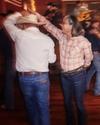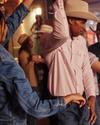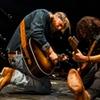
Dance halls have been the beating heart of Texan communities and Western culture for well over a hundred years. We sat down with Steph McDougal, co-founder and Executive Director of Texas Dance Hall Preservation to learn more about these iconic places with deep roots, and how to make the most of visiting them while dancin’ the night away.
Q:
What is Texas Dance Hall Preservation, and what do you do?
A:
Founded in 2007, Texas Dance Hall Preservation (TDHP) is a nonprofit organization dedicated to celebrating historic Texas dance halls by helping them strengthen and serve their communities. TDHP supports dance halls in many ways, including through our Preservation Fund grant program, which helps halls make repairs and improvements. We also recognize that dance halls are good for business and support their local economies, so we encourage dance hall visitors to shop, dine, and stay in the communities where halls are located.
Q:
What is a dance hall?
A:
Dance halls were Texas’ original community centers, and today they still fill that role. Dance halls are where Texans celebrate weddings and family reunions, meet up with friends and neighbors, and support the volunteer fire department fundraiser. Some dance halls even serve as emergency shelters during natural disasters!
We are often asked, “What’s the difference between a dance hall and a honky tonk?” TDHP is very inclusive. However, we define a “dance hall” for our Preservation Fund grant program this way:
1. The building must have been used for community dances at some point in its history; it is not required to currently be in use for dancing.
2. A dance hall may be a freestanding building or part of a larger building (e.g., on one floor of a multi-story commercial building).
3. The hall must still include a dedicated dance floor and a stage or other designated area for bands.
4. The hall may include a bar, kitchen, and eating area, but the hall’s primary use must have been as a dance hall or community hall, not as a restaurant or bar.
5. The hall must be largely intact; it cannot be a ruin or partially destroyed.
Q:
What are the oldest dance halls in Texas?
A:
Some halls that are currently still standing were built in the 1870s. However, dance halls that are on the ground today might be the second, third, or even fourth building to serve that purpose. It also was not uncommon for older buildings to be repurposed as dance halls later in their history. As you can see, it gets complicated really quickly, so TDHP doesn’t weigh in on which hall is “the oldest dance hall.” However, we are getting ready to recognize “Century Halls” that are at least 100 years old.
Q:
Where are Texas dance halls located?
A:
You can find dance halls throughout Texas! Most people probably are familiar with the many German and Czech halls in the Texas Hill Country, because those have received the most publicity over the years. And because fewer people live in far West Texas, you’re likely to find fewer dance halls out that way. TDHP is currently working on a new interactive map of Texas dance halls, in partnership with the University of Texas at San Antonio’s Center for Cultural Sustainability, which we hope to launch on our website later this year. As part of that effort, we have identified hundreds of halls all over Texas that we were not previously aware of.
Q:
What should I know about going to a Texas dance hall?
A:
We hope that everyone will enjoy themselves at a dance hall! Mostly just be kind and courteous to others. If you don’t know how to dance, and the hall doesn’t offer lessons, taking a few lessons before you go will make your evening more fun. If you’re not sure about dance floor etiquette, feel free to ask questions. Please don’t put anything on the floor to make it more slippery without asking and receiving permission from the managers. Try to stay out of the way of other dancers, and if you run into someone, apologize whether you think it was your fault or not. Support the kitchen and bar, don’t complain about the prices, and tip your bartender.
Q:
What kind of dances do you do at a dance hall?
A:
The Texas two-step is the main dance that you’ll see at many dance halls. The two-step might have a Western Swing flavor or a Tejano flavor. Depending on the music, you might also enjoy a waltz, polka, Cotton-Eyed Joe or Schottische; Conjunto, salsa, or cumbia; line dances; and sometimes even East Coast swing or West Coast swing.
Q:
What type of boots or clothing do you recommend wearing to a dance hall?
A:
Remember that dancing is an aerobic activity, so you want to wear something that you can move in easily. Many people wear jeans and boots. A boot with a leather sole is easiest to dance in because it slides across the floor. I own several pairs of boots, but at TDHP’s last dance, “Swing Into Fayetteville” in December 2023, I wore my black Tecovas “Jamie” boots.
See y’all on the dance floor!
Credits
Interview with Texas Dance Hall Preservation, Inc.
Steph McDougal, co-founder and interim executive director















